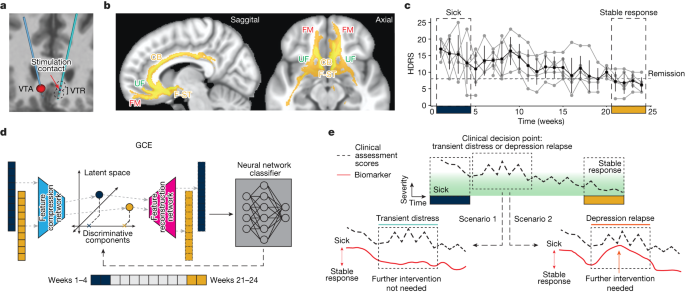2023-09-18 ジョージア工科大学
◆DBSは電極を脳に埋め込んで電気刺激を送る治療法で、パーキンソン病などで使用されていますが、うつ病治療では実験的です。この研究は、DBSデバイスから得られた客観的データを使用して治療反応を指導し、治療を最適化するための重要なステップです。
<関連情報>
- https://research.gatech.edu/researchers-identify-crucial-biomarker-tracks-recovery-treatment-resistant-depression
- https://www.nature.com/articles/s41586-023-06541-3
深部脳刺激によるうつ病回復を追跡する帯状回動態 Cingulate dynamics track depression recovery with deep brain stimulation
Sankaraleengam Alagapan,Ki Sueng Choi,Stephen Heisig,Patricio Riva-Posse,Andrea Crowell,Vineet Tiruvadi,Mosadoluwa Obatusin,Ashan Veerakumar,Allison C. Waters,Robert E. Gross,Sinead Quinn,Lydia Denison,Matthew O’Shaughnessy,Marissa Connor,Gregory Canal,Jungho Cha,Rachel Hershenberg,Tanya Nauvel,Faical Isbaine,Muhammad Furqan Afzal,Martijn Figee,Brian H. Kopell,Robert Butera,Helen S. Mayberg & Christopher J. Rozell
Nature Published:20 September 2023
DOI:https://doi.org/10.1038/s41586-023-06541-3

Abstract
Deep brain stimulation (DBS) of the subcallosal cingulate (SCC) can provide long-term symptom relief for treatment-resistant depression (TRD)1. However, achieving stable recovery is unpredictable2, typically requiring trial-and-error stimulation adjustments due to individual recovery trajectories and subjective symptom reporting3. We currently lack objective brain-based biomarkers to guide clinical decisions by distinguishing natural transient mood fluctuations from situations requiring intervention. To address this gap, we used a new device enabling electrophysiology recording to deliver SCC DBS to ten TRD participants (ClinicalTrials.gov identifier NCT01984710). At the study endpoint of 24 weeks, 90% of participants demonstrated robust clinical response, and 70% achieved remission. Using SCC local field potentials available from six participants, we deployed an explainable artificial intelligence approach to identify SCC local field potential changes indicating the patient’s current clinical state. This biomarker is distinct from transient stimulation effects, sensitive to therapeutic adjustments and accurate at capturing individual recovery states. Variable recovery trajectories are predicted by the degree of preoperative damage to the structural integrity and functional connectivity within the targeted white matter treatment network, and are matched by objective facial expression changes detected using data-driven video analysis. Our results demonstrate the utility of objective biomarkers in the management of personalized SCC DBS and provide new insight into the relationship between multifaceted (functional, anatomical and behavioural) features of TRD pathology, motivating further research into causes of variability in depression treatment.


